Class 10 R S AGGARWAL AND V AGGARWAL Solutions Maths Chapter 15 - Perimeter and Area of Plane Figures
Perimeter and Area of Plane Figures Exercise Ex. 15A
Solution 1

Solution 2
Let a = 42 cm, b = 34 cm and c = 20 cm

(i)Area of triangle = ![]()
![]()
(ii)Let base = 42 cm and corresponding height = h cm
Then area of triangle = ![]()
![]()
Hence, the height corresponding to the longest side = 16 cm
Solution 3
Let a = 18 cm, b = 24 cm, c = 30 cm
Then,2s = (18 + 24 + 30) cm = 72 cm
s = 36 cm
(s a) = 18cm, (s b) = 12 cm and (s c) = 6 cm
(i)Area of triangle = ![]()
![]()
(ii)Let base = 18 cm and altitude = x cm
Then, area of triangle = ![]()
![]()
Hence, altitude corresponding to the smallest side = 24 cm
Solution 4
On dividing 150 m in the ratio 5 : 12 : 13, we get
Length of one side = ![]()
Length of the second side = ![]()
Length of third side = ![]()
Let a = 25 m, b = 60 m, c = 65 m
![]()
(s a) = 50 cm, (s b) = 15 cm, and (s c) = 10 cm

Hence, area of the triangle = 750 m2
Solution 5
On dividing 540 m in the ratio 25 : 17 : 12, we get
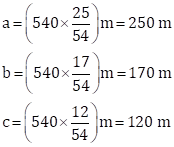
Then,

Therefore, area of triangular field

Cost of ploughing 100 m2 field = Rs. 40
Then, cost of ploughing 9000 m2 field ![]()
Solution 6
Let the length of one side be x cm
Then the length of other side = {40 (17 + x)} cm = (23 - x) cm
Hypotenuse = 17 cm
Applying Pythagoras theorem, we get


Hence, area of the triangle = 60 cm2
Solution 7
Let the sides containing the right - angle be x cm and (x - 7) cm

One side = 15 cm and other = (15 - 7) cm = 8 cm

![]() perimeter of triangle (15 + 8 + 17) cm = 40 cm
perimeter of triangle (15 + 8 + 17) cm = 40 cm
Solution 8
Let the sides containing the right angle be x and (x-2) cm


One side = 8 cm, and other (8-2) cm = 6 cm

= 10 cm
Therefore, perimeter of the triangle = 8 + 6 + 10 = 24 cm
Solution 9

Solution 10
Let each side of an equilateral triangle = ![]() cm
cm
Then,
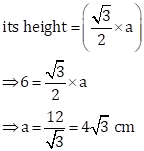
Therefore, area of an equilateral triangle

Solution 11
Let each side of the equilateral triangle be a cm

Perimeter of equilateral triangle = 3a = (3x12) cm = 36 cm
Solution 12
Let each side of the equilateral triangle be a cm
![]() area of equilateral triangle =
area of equilateral triangle =![]()

Height of equilateral triangle
![]()
Solution 13
Base of right angled triangle = 48 cm
Height of the right angled triangle =![]()

Solution 14
Let the hypotenuse of right - angle triangle = 65cm
Base = 60 m

Hence, perpendicular = 25 cm and area of the triangle =750 cm2
Solution 15
The circumcentre of a right - triangle is the midpoint of the hypotenuse
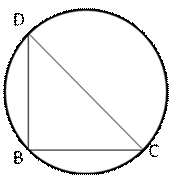
Hypotenuse = 2 × (radius of circumcircle)
= (2 × 8) cm = 16 cm
Base = 16 cm, height = 6 cm
Area of right angled triangle

Hence, area of the triangle= 48 cm2
Solution 16
Let each equal side be a cm in length.
Then,
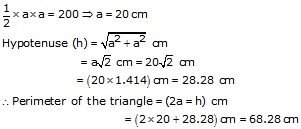
Hence, hypotenuse = 28.28 cm and perimeter = 68.28 cm
Solution 17
Let each equal side be a cm and base = 80 cm


![]() perimeter of triangle = (2a + b) cm
perimeter of triangle = (2a + b) cm
= (2 41 + 80) cm
= (82 + 80) cm = 162 cm
Hence, perimeter of the triangle = 162 cm
Solution 18
Let the height be h cm, then a= (h + 2) cm and b = 12 cm

Squaring both sides,

Therefore, a = h + 2 = (8 + 2)cm = 10 cm

Hence, area of the triangle = 48 cm2.
Solution 19
Let ![]() ABC is a isosceles triangle. Let AC, BC be the equal sides
ABC is a isosceles triangle. Let AC, BC be the equal sides
Then AC = BC = 10cm. Let AB be the base of ![]() ABC right angle at C.
ABC right angle at C.
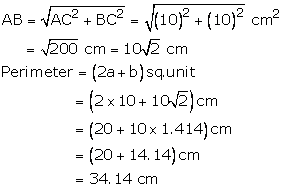
Area of right isosceles triangle ABC
![]()
Hence, area = 50 cm2 and perimeter = 34.14 cm
Solution 20
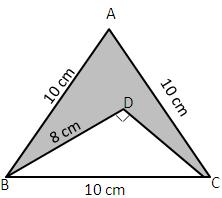
Area of shaded region = Area of ![]() ABC – Area of
ABC – Area of ![]() DBC
DBC
First we find area of ![]() ABC
ABC

Second we find area of ![]() DBC which is right angled
DBC which is right angled
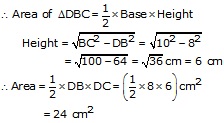
Area of shaded region = Area of ![]() ABC – Area of
ABC – Area of ![]() DBC
DBC
= (43.30 - 24) ![]() = 19. 30
= 19. 30 ![]()
Area of shaded region = 19.3 ![]()
Perimeter and Area of Plane Figures Exercise Ex. 15B
Solution 1
Let the length of a rectangular plot = L m
Given, perimeter = 80 m and breadth = 16 m
Now,
Perimeter of a rectangular plot = 2(Length + Breadth)
⇒ 80 = 2(L + 16)
⇒ 40 = L + 16
⇒ L = 24 m
Therefore, area of the plot = Length × Breadth
= 24 m × 16 m
= 384 m2
Solution 2

Solution 3
Let the other side of a rectangle = ![]() cm
cm
Then, by Pythagoras theorem,

And, area of a rectangle = 35 cm × 12 cm = 420 cm2
Solution 4
Let the breadth of a rectangular plot = ![]() m
m
Given, area of the rectangular plot = 462 m2
⇒ Length × Breadth = 462
⇒ 28 × ![]() = 462
= 462
⇒ ![]() = 16.5 cm
= 16.5 cm
Now, perimeter of a rectangular plot = 2(Length + Breadth)
= 2(28 + 16.5)
= 2(44.5)
= 89 m
Solution 5

Solution 6

Solution 7
Area of floor = Length Breadth
![]()
Area of carpet = Length Breadth
= ![]()
Number of carpets = 
= 216
Hence the number of carpet pieces required = 216
Solution 8
Area of verandah = (36 × 15) ![]() = 540
= 540 ![]()
Area of stone = (0.6 × 0.5) ![]() [10 dm = 1 m]
[10 dm = 1 m]
Number of stones required = ![]()
Hence, 1800 stones are required to pave the verandah.
Solution 9
Perimeter of rectangle = 2(l + b)
![]() 2(l + b) = 56 Þ l + b = 28 cm
2(l + b) = 56 Þ l + b = 28 cm
b = (28 l) cm
Area of rectangle = 192![]()
l (28 l) = 192
28l - ![]() = 192
= 192
![]() - 28l + 192 = 0
- 28l + 192 = 0
![]() - 16l 12l + 192 = 0
- 16l 12l + 192 = 0
l(l 16) 12(l 16) = 0
(l 16) (l 12) = 0
l = 16 or l = 12
Therefore, length = 16 cm and breadth = 12 cm
Solution 10
Length of the park = 35 m
Breadth of the park = 18 m
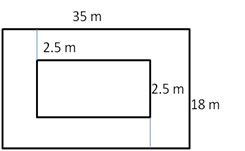
Area of the park = (35 18) ![]() = 630
= 630 ![]()
Length of the park with grass =(35 5) = 30 m
Breadth of the park with grass = (18- 5) m = 13 m
Area of park with grass = (30 13) ![]() = 390
= 390 ![]()
Area of path without grass = Area of the whole park area of park with grass
= 630 ![]() - 390
- 390 ![]() = 240
= 240 ![]()
Hence, area of the park to be laid with grass = 240 m2
Solution 11
Length of the plot = 125 m
Breadth of the plot = 78 m
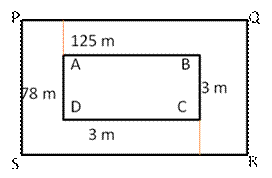
Area of plot ABCD = (125 78) ![]() = 9750
= 9750 ![]()
Length of the plot including the path= (125 + 3 + 3) m = 131 m
Breadth of the plot including the path = (78 + 3 + 3) m = 84 m
Area of plot PQRS including the path
= (131 84) ![]() = 11004
= 11004 ![]()
Area of path = Area of plot PQRS Area of plot ABCD
= (11004 9750) ![]()
= 1254 ![]()
Cost of gravelling = Rs 75 per m2
![]() Cost of gravelling the whole path = Rs. (1254 75) = Rs. 94050
Cost of gravelling the whole path = Rs. (1254 75) = Rs. 94050
Hence, cost of gravelling the path = Rs 94050
Solution 12(i)
Area of rectangular field including the foot path = (54 35) ![]()
Let the width of the path be x m
Then, area of rectangle plot excluding the path = (54 2x) (35 2x)
Area of path = (54 35) (54 2x) (35 2x)
(54 35) (54 2x) (35 2x) = 420
1890 1890 + 108x + 70x - 4![]() = 420
= 420
178x - 4![]() = 420
= 420
4![]() - 178x + 420 = 0
- 178x + 420 = 0
2![]() - 89x + 210 = 0
- 89x + 210 = 0
2![]() - 84x 5x + 210 = 0
- 84x 5x + 210 = 0
2x(x 42) 5(x 42) = 0
(x 42) (2x 5) = 0

Solution 12(ii)
Let the width of the border = b m
Then, the length of a carpet = (8 - b - b) = (8 - 2b) m
And, the breadth of a carpet = (5 - b - b) = (5 - 2b) m
∴ Area of a carpet = (8 - 2b) × (5 - 2b) = (40 - 26b + 4b2) m2
Length of a room = 8 m
Breadth of a room = 5 m
∴ Area of a room = 8 × 5 = 40 m2
Given, area of border = 12 m2
Now,
Area of a carpet = Area of a room - Area of a border
⇒ (40 - 26b + 4b2) = 40 - 12
⇒ 4b2 - 26b + 12 = 0
⇒ 2b2 - 13b + 6 = 0
⇒ 2b2 - 12b - b + 6 = 0
⇒ 2b(b - 6) - (b - 6) = 0
⇒ (b - 6)(2b - 1) = 0
⇒ b - 6 = 0 or 2b - 1 = 0
⇒ b = 6 or b = ½
b ≠ 6 as width of the border cannot be greater than width of the room.
⇒ b = ½ = 0.5 m = 50 cm
Hence, the width of the carpet is 50 cm.
Solution 13
Let the length and breadth of a rectangular garden be 9x and 5x.
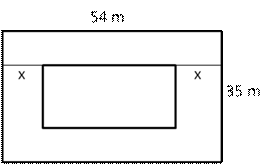
Then, area of garden = (9x 5x)m = 45![]()
Length of park excluding the path = (9x 7) m
Breadth of the park excluding the path = (5x 7) m
Area of the park excluding the path = (9x 7)(5x 7) ![]()
![]() Area of the path =
Area of the path = ![]()

![]() (98x 49) = 1911
(98x 49) = 1911
98x = 1911 + 49
![]()
Length = 9x = 9 20 = 180 m
Breadth = 5x = 5 20 = 100 m
Hence, length = 180 m and breadth = 100 m
Solution 14

Solution 15
Let the width of the grass strip = b m
Then, the length of the pond = (50 - b - b) = (50 - 2b) m
And, the breadth of the pond = (40 - b - b) = (40 - 2b) m
∴ Area of the pond = (50 - 2b) × (40 - 2b) = (2000 - 180b + 4b2) m2
Length of a park = 50 m
Breadth of a park = 40 m
∴ Area of a park = 50 × 40 = 2000 m2
Given, area of the grass strip = 1184 m2
Now,
Area of the pond = Area of a park - Area of the grass strip
⇒ (2000 - 180b + 4b2) = 2000 - 1184
⇒ 4b2 - 180b + 1184 = 0
⇒ b2 - 45b + 296 = 0
⇒ b2 - 37b - 8b + 296 = 0
⇒ b(b - 37) - 8(b - 37) = 0
⇒ (b - 37)(b - 8) = 0
⇒ b - 37 = 0 or b - 8 = 0
⇒ b = 37 or b = 8
b ≠ 37 as width of the grass strip at both ends is exceeding 50 m.
⇒ b = 8 m
⇒ Length of the pond = 50 - 2(8) = 34 m and breadth of the pond = 40 - 2(8) = 24 m.
Solution 16
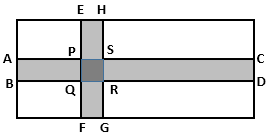

Solution 17

Solution 18

Solution 19

Solution 20
Area of the square = ![]()
Let diagonal of square be x
![]()
Length of diagonal = 16 cm
Side of square = ![]()
Perimeter of square = [4 side] sq. units
=[ 4 11.31] cm = 45.24 cm
Solution 21
Let d meter be the length of diagonal
Area of square field = ![]()

Time taken to cross the field along the diagonal

Hence, man will take 6 min to cross the field diagonally.
Solution 22

Solution 23
Rs. 14 is the cost of fencing a length = 1m
Rs. 28000 is the cost of fencing the length= ![]()
Perimeter = 4 side = 2000
![]() side = 500 m
side = 500 m
Area of a square = ![]()
= 250000 ![]()
Cost of mowing the lawn =![]()
Solution 24

Solution 25
ABCD be the given quadrilateral in which AD = 24 cm, BD = 26 cm, DC = 26 cm and BC = 26 cm
By Pythagoras theorem

For area of equilateral ![]() DBC, we have
DBC, we have
a = 26 cm

Area of quad. ABCD = Area of ![]() ABD + Area of
ABD + Area of ![]() DBC
DBC
= (120 + 292.37) ![]() = 412.37
= 412.37 ![]()
Perimeter ABCD = AD + AB + BC + CD
= 24 cm + 10 cm + 26 cm + 26 cm
= 86 cm
Solution 26

Area of quad. ABCD = Area of ![]() ABC + Area of
ABC + Area of ![]() ACD
ACD

Now, we find area of a ![]() ACD
ACD


Area of quad. ABCD = Area of ![]() ABC + Area of
ABC + Area of ![]() ACD
ACD
![]()
Perimeter of quad. ABCD = AB + BC + CD + AD
=(17 + 8 + 12 + 9) cm
= 46 cm
![]() Perimeter of quad. ABCD = 46 cm
Perimeter of quad. ABCD = 46 cm
Solution 27
Area of quad. ABCD = Area of ABD + Area of
DBC
For area of ABD
Let a = 42 cm, b = 34 cm, and c = 20 cm


For area of DBC
a = 29 cm, b = 21 cm, c = 20 cm
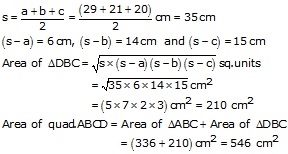
Solution 28
Area of the ||gm = (base height) sq. unit
= (25 16.8) ![]()
Solution 29
Longer side = 32 cm, shorter side = 24 cm
Distance between longer sides = 17.4 cm
Let the distance between the shorter sides be x cm
Area of ||gm = (longer side distance between longer sides)
= (shorter side distance between the short sides)

![]() distance between the shorter side = 23.2 cm
distance between the shorter side = 23.2 cm
Solution 30

Solution 31
Area ofparallelogram = 2 area of DABC
Opposite sides of parallelogram are equal
AD = BC = 20 cm
And AB = DC = 34 cm
In ![]() ABC we have
ABC we have
a = AC = 42 cm
b = AB = 34 cm
c = BC = 20 cm

Then, (s a) = 6 cm, (s b) = 14 cm and (s c) = 28 cm


Solution 32

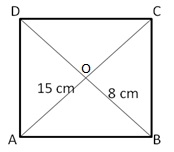
We know that the diagonals of a rhombus, bisect each other at right angles
OA = OC = 15 cm,
And OB = OD = 8 cm
And ![]() AOB = 90
AOB = 90
![]() By Pythagoras theorem, we have
By Pythagoras theorem, we have

Solution 33
(i)Perimeter of rhombus = 4 side
![]() 4 side = 60 cm
4 side = 60 cm
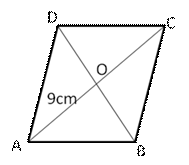

By Pythagoras theorem

OB = 12 cm
OB = OD = 12 cm
![]() BD = OB + OD = 12 cm + 12 cm = 24 cm
BD = OB + OD = 12 cm + 12 cm = 24 cm
Length of second diagonal is 24 cm
(ii) Area of rhombus = ![]()

Solution 34
(i)Area of rhombus = 480 ![]()
One of its diagonals = 48 cm
Let the second diagonal =x cm


Hence the length of second diagonal 20 cm
(ii)We know that the diagonals of a rhombus bisect each other at right angles
![]() AC = 48, BD = 20 cm
AC = 48, BD = 20 cm
![]() OA = OC = 24 cm and OB = OD = 10 cm
OA = OC = 24 cm and OB = OD = 10 cm
By Pythagoras theorem , we have

(iii)![]() Perimeter of the rhombus = (4 26) cm = 104 cm
Perimeter of the rhombus = (4 26) cm = 104 cm
Solution 35

Solution 36
Areaof cross section = ![]()

Solution 37
Let ABCD be a given trapezium in which
AB = 25, CD = 11
BC = 15, AD = 13
Draw CE || AD
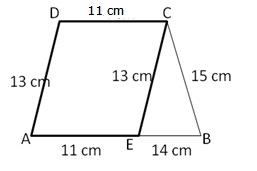
In ||gm ADCE, AD || CE and AE || CD
AE = CD = 11 cm,
And BE = AB BE
= 25 11 = 14 cm
In BEC,
![]()
Area of BEC =
![]()
![]()
Let height of ![]() BEC is h
BEC is h
Area of ![]() BEC =
BEC = ![]()
From (1) and (2), we get
7h = 84 ![]() h = 12 m
h = 12 m
Area of trapezium ABCD

Perimeter and Area of Plane Figures Exercise MCQ
Solution 1

Solution 2

Solution 3
![]()
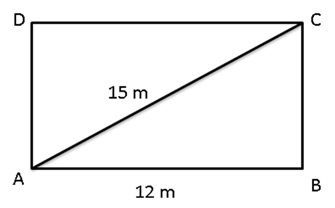

Solution 4

Solution 5
![]()
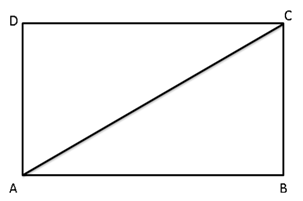

Solution 6

Solution 7

Solution 8
![]()
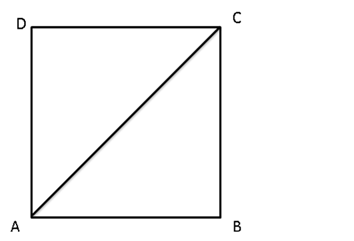

Solution 9

Solution 10

Solution 11

Solution 12

Solution 13

Solution 14

Solution 15

Solution 16

Solution 17

Solution 18

Solution 19
![]()


Solution 20
![]()
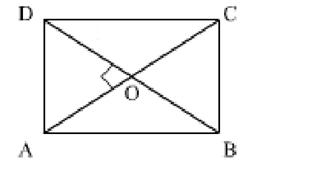

Perimeter and Area of Plane Figures Exercise Test Yourself
Solution 1

Solution 2

Solution 3

Solution 4

Solution 5

Solution 6

Solution 7
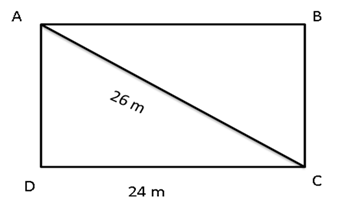

Solution 8

Solution 9

Solution 10

Solution 11

Solution 12


Solution 13
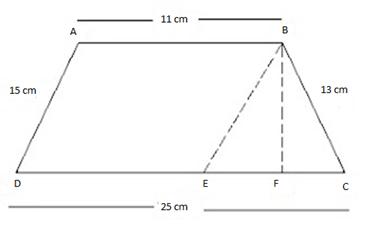

Solution 14

Solution 15
Let the side of a square lawn = S metre
Then,
4S × 14 = 2800
⇒ 4S = 200
⇒ S = 50 m
⇒ Area of a square lawn = (50 m)2 = 2500 m2
Now,
cost of mowing 100 m2 lawn = Rs. 54
Then, cost of mowing 2500 m2 lawn ![]()
Therefore, the cost of mowing the lawn is Rs. 1350.
Solution 16

Solution 17

Solution 18
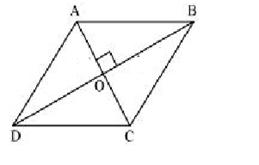

Solution 19

Solution 20



